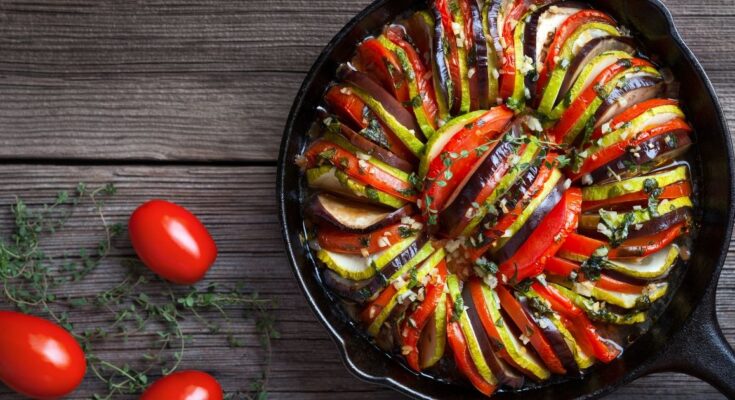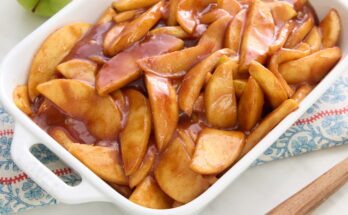French Ratatouille Recipe: Let’s be honest—when you think of French cuisine, you probably imagine croissants, escargot, and buttery sauces. But hidden among these indulgent delights is one of the healthiest, most vibrant, and comforting dishes ever created: ratatouille. Not only is it a visual stunner, but it’s also a deliciously hearty stew that brings together summer’s best vegetables. Whether you’re trying to eat clean, go meatless, or just want something flavorful and satisfying, this French Ratatouille recipe is the answer.
Forget the animated movie for a second (though we all love Remy!). Ratatouille has deep roots in French culture, particularly in the sunny region of Provence. It’s rustic, humble, and soul-soothing—a dish that lets veggies shine in all their juicy, savory glory.
This step-by-step guide will walk you through every part of the process—from selecting the freshest produce to layering the flavors just right. Ready to bring a bit of the French countryside into your kitchen? Let’s dive in.
What is Ratatouille?
At its core, ratatouille is a vegetable stew, traditionally made with tomatoes, eggplant, zucchini, bell peppers, onions, and lots of fresh herbs like thyme, basil, and parsley. It’s known for its rustic charm and layered flavors. There’s no fancy technique involved, just a bit of patience, love, and attention to the natural goodness of each ingredient.
Originating from Nice, France, this dish began as a humble meal made by peasants using readily available vegetables. Over time, it evolved into a celebrated part of French culinary heritage. Some chefs opt for the chunky stew version, while others prefer the elegantly layered oven-baked rendition, also known as Confit Byaldi.
Today, it’s enjoyed worldwide and often customized with regional or seasonal tweaks. The beauty of ratatouille is that it celebrates simplicity, yet it’s packed with complex flavors that deepen as it simmers. You can serve it hot or cold, solo or with a side—it’s versatile like that.
Why You’ll Love This Recipe
If you’re someone who likes their food to look good, taste amazing, and feel nourishing, you’re going to fall in love with ratatouille. Here’s why this recipe is a keeper:
- Healthy & Nutritious: Packed with fiber, vitamins, and antioxidants. No processed junk.
- Vegan & Gluten-Free: Perfect for anyone with dietary restrictions.
- Meal-Prep Friendly: Tastes even better the next day. Make a big batch and enjoy it all week.
- Totally Customizable: Add chickpeas for protein, top it with feta, or serve it over pasta.
- Bursting with Mediterranean Flavors: Garlic, olive oil, and fresh herbs give it that sun-kissed taste.
Whether you’re hosting a dinner party or just want a cozy night-in meal, this recipe won’t let you down.
List of Ingredients You’ll Need
Ready to cook? Great! Here’s your ingredient checklist for the perfect French ratatouille:
Fresh Vegetables
- 2 medium zucchinis – sliced into rounds or half-moons
- 1 medium eggplant – diced or sliced thin
- 1 red bell pepper – chopped
- 1 yellow bell pepper – chopped
- 1 green bell pepper – optional for more color
- 1 large yellow onion – finely chopped
- 4-5 ripe tomatoes – diced or crushed (or use canned if not in season)
- 3-4 garlic cloves – minced
Herbs & Seasonings
- 2 tablespoons olive oil – for sautéing
- 1 teaspoon dried thyme
- 1 teaspoon dried oregano
- 1 teaspoon Herbes de Provence (optional, but traditional)
- Fresh basil leaves – for garnish
- Salt & pepper – to taste
Optional Add-ons
- Bay leaf – for simmering
- Red pepper flakes – for heat
- Fresh parsley – chopped for garnish
- Parmesan or vegan cheese – for topping
You don’t need fancy ingredients—just fresh, high-quality produce. That’s where the magic happens.
Tools & Equipment Required
You don’t need a Michelin-star kitchen to make authentic ratatouille, but having the right tools makes the process smoother.
Basic Kitchen Tools
- Large sauté pan or skillet (with a lid)
- Sharp chef’s knife
- Cutting board
- Wooden spoon or spatula
- Large pot (if making stew version)
Optional Equipment
- Mandoline slicer (for uniform slices if making layered oven version)
- Dutch oven or casserole dish (for baking)
- Blender or food processor (if making tomato sauce separately)
Prepping is half the battle, and with the right tools on hand, you’ll enjoy the process instead of feeling like you’re juggling knives.
How to Choose the Best Vegetables
Picking quality veggies is the foundation of a killer ratatouille. You’re letting the ingredients speak for themselves, so each one needs to be at its best.
- Zucchini & Eggplant: Look for smooth, shiny skin and firmness. Avoid wrinkled or overly soft ones.
- Bell Peppers: Should feel heavy and crisp. The more vibrant, the better.
- Tomatoes: In-season, vine-ripened tomatoes are ideal. Off-season? Go for canned San Marzano.
- Onions & Garlic: Fresh and firm, no sprouts or soft spots.
- Herbs: Choose fresh, aromatic herbs whenever possible. Dried is fine, but fresh basil makes a big difference.
Go for organic if your budget allows—it’s especially helpful when eating the skin. If not, just wash thoroughly and pat dry.
Prepping the Ingredients
Now that you’ve picked out the best of the bunch, it’s time to get everything ready for the stovetop. Trust me—this is the step where the real fun begins. Prepping your vegetables properly ensures even cooking, maximum flavor, and that beautiful rustic texture ratatouille is known for.
Start by washing all your veggies thoroughly. You’ll be cooking most of them with the skin on, so don’t skimp on the scrubbing. Use a vegetable brush if needed, especially on the eggplant and zucchini.
Chopping Techniques
- Zucchini & Eggplant: Slice into even rounds or half-moons, about ¼ inch thick. You can also dice them if you prefer a chunkier stew.
- Bell Peppers: Core them, remove the seeds, and cut into bite-sized chunks or strips. The variety of colors makes the dish visually stunning.
- Onions & Garlic: Finely chop the onions. For garlic, mince it so it distributes evenly throughout the stew.
- Tomatoes: If using fresh tomatoes, you can blanch them in hot water for 30 seconds, then peel and dice them. Or just dice them with the skin on if you’re short on time.
- Herbs: Strip the leaves from any woody stems (like thyme) and chop parsley or basil if using fresh.
Here’s a pro tip: salt your eggplant slices lightly and let them sit for 15–20 minutes. This draws out any bitterness and extra moisture, giving you a meatier texture after cooking.
Lastly, lay everything out on the counter so it’s within reach. Having a mise en place (everything in its place) will make the cooking process smoother, faster, and more enjoyable.
The Classic Cooking Method
There are a couple of ways to make ratatouille, but the classic French method involves cooking each vegetable separately before combining them. Why? Because each veggie cooks at a different rate. This method lets each one develop its own flavor and texture instead of turning into mush.
Step-by-Step for the Traditional Stove-Top Method:
- Heat olive oil in a large skillet or Dutch oven over medium heat.
- Sauté eggplant first. It soaks up oil fast, so keep an eye on it. Cook until golden and soft. Remove and set aside.
- Next, cook zucchini until lightly browned. Remove and set aside.
- Cook peppers and onions together. They soften faster and complement each other well.
- Add garlic and stir for about 30 seconds to release its aroma—don’t let it burn!
- Stir in chopped tomatoes, herbs, and a pinch of salt and pepper. Let this mixture simmer for 10–15 minutes until it becomes saucy.
- Return all the cooked veggies to the pot. Stir gently to combine everything.
- Simmer on low heat, covered, for another 20–30 minutes, stirring occasionally. You want everything tender, not mushy.
This method may take a bit longer, but the flavor payoff is totally worth it. Each bite will have distinct textures, all mingling together in a rich, garlicky, herb-infused tomato sauce.
Oven-Baked Ratatouille (Confit Byaldi Style)
Want to go a bit fancy and channel your inner Remy from Ratatouille? Try the oven-baked, layered version, also known as Confit Byaldi. This method is all about presentation and gentle, slow roasting that makes the vegetables melt in your mouth.
Here’s how to do it:
- Make a base sauce with onions, garlic, and tomatoes—simmer it until thick.
- Spread the sauce into a baking dish.
- Thinly slice zucchini, eggplant, and bell peppers using a mandoline or sharp knife.
- Layer the slices over the tomato base, alternating colors in a spiral or overlapping rows. Think of it as painting with vegetables.
- Drizzle with olive oil, sprinkle herbs and seasonings on top.
- Cover with foil and bake at 375°F (190°C) for 40 minutes.
- Remove foil and bake uncovered for another 20 minutes for some browning.
This method creates a soft, almost caramelized texture, and the visual effect is stunning. It’s perfect for dinner parties or when you want to impress someone with your cooking skills.
Step-by-Step Guide to Making French Ratatouille
Here’s the complete breakdown of how to make traditional stovetop ratatouille from scratch. Let’s go step-by-step.
Step 1: Gather All Ingredients
Make sure everything is washed, chopped, and laid out. Check your pantry for herbs, olive oil, and seasonings. This step helps you avoid scrambling mid-recipe.
Step 2: Slice and Dice Veggies
Uniformity is key here. Try to keep the size of your veggie chunks consistent for even cooking. Use the tips from the prepping section to guide your cuts.
Step 3: Sauté and Soften Vegetables
Cook each vegetable separately in olive oil. Start with eggplant, then zucchini, followed by peppers and onions. Add garlic last to avoid burning. Set each batch aside in a large bowl once done.
Step 4: Make the Tomato Base
Add chopped tomatoes (or crushed canned ones) into the skillet. Add salt, pepper, thyme, and Herbes de Provence. Let it simmer until thick—about 10–15 minutes.
Step 5: Combine and Simmer
Return all cooked vegetables to the tomato base. Stir gently to mix. Cover and simmer over low heat for 20–30 minutes. The longer it simmers, the better the flavors meld.
Step 6: Serve and Enjoy
Serve warm with crusty bread, rice, or couscous. You can also refrigerate and serve it cold as an appetizer or salad.
Tips for the Best Ratatouille
Want to take your ratatouille from good to unforgettable? Try these pro tips:
- Cook vegetables in batches: Don’t overcrowd the pan. Let them brown nicely.
- Use a heavy-bottomed pot: Helps maintain even heat and prevents burning.
- Let it rest: Flavors intensify if you let the dish sit for a few hours or overnight.
- Drizzle with olive oil before serving: Adds richness and shine.
- Add a splash of balsamic vinegar or lemon juice at the end for brightness.
Avoid overcooking—it turns everything to mush. You want the vegetables to be tender yet still recognizable.
Serving Suggestions
Ratatouille is super versatile. Here’s how to serve it like a pro:
- With crusty French bread or a baguette
- Over a bed of rice, quinoa, or couscous
- Tossed with pasta
- As a side dish for grilled meat or fish
- Topped with a fried egg or goat cheese for brunch vibes
- As a filling for crepes, sandwiches, or wraps
You can even blend leftovers into a soup or sauce. It’s that flexible.
How to Store and Reheat Leftovers
So you’ve made a big, beautiful batch of ratatouille—great choice! Now let’s talk leftovers, because if there’s one dish that tastes even better the next day, it’s this one. The flavors continue to meld, deepen, and develop complexity over time. Ratatouille is truly one of those meals that rewards a little patience.
Refrigeration
Once your ratatouille has cooled to room temperature, store it in an airtight container and pop it in the fridge. It’ll stay fresh and delicious for up to 5 days.
- Tip: Use glass containers if you can. They don’t retain smells and are microwave-safe.
- If you’ve made a large batch, divide it into smaller portions. This makes reheating quicker and easier—and saves you from reheating the entire pot every time.
Freezing
Yes, you can absolutely freeze ratatouille!
- Let it cool completely first.
- Transfer it to freezer-safe bags or containers.
- Label with the date and store flat to save space.
Frozen ratatouille will stay good for up to 3 months. Just thaw overnight in the fridge before reheating.
Reheating Instructions
You’ve got a few options when it comes to bringing your ratatouille back to life:
- Microwave: Place in a microwave-safe dish, cover loosely, and heat in 1-minute bursts, stirring in between.
- Stovetop: Pour into a saucepan, add a splash of water or broth, and warm on low heat until bubbling.
- Oven: Preheat to 350°F (175°C), place in a baking dish, cover with foil, and bake for 15–20 minutes.
Whatever method you choose, just don’t overcook it during reheating. You want to maintain the texture of the veggies—not turn them into mush.
Ratatouille Variations
One of the best things about ratatouille? You can make it your own. While the classic version is a total showstopper, don’t be afraid to add a personal twist. Here are a few delicious ideas to change it up:
Add Protein
- Chickpeas: For a vegan protein punch, stir in cooked chickpeas during the last 10 minutes of simmering.
- Tofu or Tempeh: Pan-fry until golden and add at the end.
- Chicken or Sausage: Brown and cook separately, then mix in to turn it into a hearty, meat-based meal.
Spicy Ratatouille
- Add red pepper flakes, chopped jalapeños, or a dash of harissa for some heat.
- Try a Cajun or Mexican spice blend to add a whole new flavor profile.
Baked Ratatouille Casserole
- Layer with mozzarella, parmesan, or vegan cheese in a baking dish and bake until bubbly.
- Top with breadcrumbs for crunch.
Moroccan Twist
- Add cumin, cinnamon, and coriander.
- Throw in chickpeas and raisins for sweet-savory flavor.
Mediterranean Style
- Mix in kalamata olives, capers, and a bit of lemon zest.
- Top with crumbled feta and fresh parsley.
Experimenting with different styles will not only keep things exciting but might even help you create your very own signature ratatouille!
Nutritional Information
Ratatouille isn’t just tasty and comforting—it’s also nutrient-dense, low in calories, and incredibly good for you. Let’s break it down:
| Nutrient | Per Serving (Approx.) |
|---|---|
| Calories | 120-150 kcal |
| Total Fat | 7g (mainly from olive oil) |
| Carbohydrates | 14g |
| Dietary Fiber | 4g |
| Protein | 2-3g |
| Sugar | 6g (natural from veggies) |
| Sodium | Varies (based on salt added) |
| Vitamins | A, C, K, B6 |
| Minerals | Potassium, Magnesium |
Ratatouille is:
- Gluten-free
- Low in cholesterol
- Naturally vegan
- High in antioxidants like lycopene and beta-carotene
It’s a feel-good dish through and through. You can eat it as a light main, a hearty side, or even a topping for grilled proteins.
FAQs about French Ratatouille Recipe
1. Can I make ratatouille ahead of time?
Absolutely! Ratatouille actually tastes better the next day. Make it a day in advance, let the flavors develop overnight in the fridge, and reheat gently when ready to serve.
2. Is ratatouille supposed to be mushy?
Nope! The goal is to have tender, flavorful veggies that still hold their shape. Cook each vegetable separately and simmer gently to avoid a soggy texture.
3. What can I serve with ratatouille?
It pairs beautifully with crusty bread, rice, quinoa, pasta, or even mashed potatoes. You can also serve it with grilled meats, fish, or eggs.
4. Can I skip one of the vegetables?
Sure! While the classic recipe calls for certain veggies, it’s totally fine to leave one out or replace it with another seasonal vegetable like mushrooms or squash.
5. How long does ratatouille last in the fridge?
It will stay fresh for up to 5 days in an airtight container. Just be sure to let it cool before storing.
Conclusion
There’s a reason why ratatouille has stood the test of time. It’s more than just a vegetable stew—it’s a celebration of simple, wholesome ingredients coming together in harmony. Whether you’re cooking it for the first time or you’re already a seasoned home chef, ratatouille delivers every time: rich flavor, beautiful color, and comforting aroma.
It’s a dish that embraces seasonality, encourages creativity, and feeds the soul. Best of all, it’s healthy, satisfying, and budget-friendly. You can make it on a lazy Sunday afternoon or prep it for your weekly meals. Whatever your reason, this ratatouille recipe is here to inspire—and nourish.
Bon appétit!



